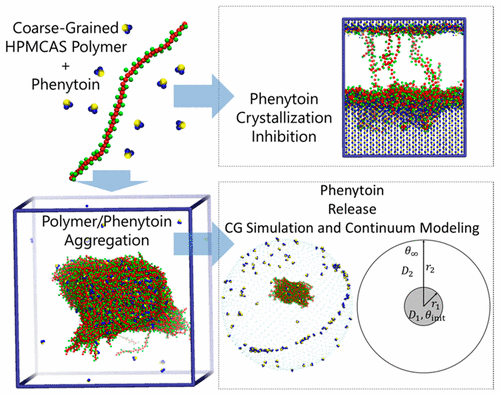当前位置:
X-MOL 学术
›
Mol. Pharmaceutics
›
论文详情
Our official English website, www.x-mol.net, welcomes your
feedback! (Note: you will need to create a separate account there.)
Multiscale Computational Modeling of the Nanostructure of Solid Dispersions of Hydroxypropyl Methylcellulose Acetate Succinate (HPMCAS) and Phenytoin
Molecular Pharmaceutics ( IF 4.5 ) Pub Date : 2017-09-05 00:00:00 , DOI: 10.1021/acs.molpharmaceut.7b00441 Wenjun Huang 1 , Taraknath Mandal 1 , Ronald G. Larson 1
Molecular Pharmaceutics ( IF 4.5 ) Pub Date : 2017-09-05 00:00:00 , DOI: 10.1021/acs.molpharmaceut.7b00441 Wenjun Huang 1 , Taraknath Mandal 1 , Ronald G. Larson 1
Affiliation

|
We recently developed coarse-grained (CG) force fields for hydroxypropyl methylcellulose acetate succinate (HPMCAS) polymers and the model drug molecule phenytoin, and a continuum transport model to study the polymer–drug nanostructures presented during a dissolution test after solvation of solid dispersion particles. We model the polymer–drug interactions that contribute to suppression of drug aggregation, release, and crystal growth during the dissolution process, and we take these as indicators of polymer effectiveness. We find that the size and the intermolecular interaction strength of the functional group and the drug loading concentration are the major factors that impact the effectiveness of the polymeric excipient. The hydroxypropyl acetyl group is the most effective functional group, followed by the acetyl group, while the deprotonated succinyl group is the least effective functional group, except that the deprotonated succinyl group at the 6-position is very effective in slowing down the phenytoin crystal growth. Our simulation results thus suggest HPMCAS with higher acetyl and lower succinyl content is more effective in promoting phenytoin solubility in dissolution media, and polymers become less effective when drug loading becomes high (i.e., 50% of the mass of the polymer/drug solid dispersion), agreeing with previous experimental studies. In addition, our transport model indicates that the drug release time from a solid dispersion particle of 2 μm diameter is less than 10 min, correlating well with the experimental time scale for a typical dissolution profile to reach maximum peak concentration. Our modeling effort, therefore, provides new avenues to understand the dissolution behavior of complex HPMCAS–phenytoin solid dispersions and offers a new design tool to optimize the formulation. Moreover, the systematic and robust approach used in our computational models can be extended to other polymeric excipients and drug candidates.
中文翻译:

羟丙基甲基纤维素乙酸琥珀酸酯(HPMCAS)和苯妥英钠固体分散体的纳米结构的多尺度计算模型
我们最近开发了羟丙基甲基纤维素醋酸琥珀酸酯(HPMCAS)聚合物和模型药物分子苯妥英钠的粗粒度(CG)力场,以及一种连续介质传输模型,用于研究固体分散体颗粒溶解后在溶出试验中呈现的聚合物-药物纳米结构。我们对在溶解过程中有助于抑制药物聚集,释放和晶体生长的聚合物-药物相互作用进行建模,并将其作为聚合物有效性的指标。我们发现官能团的大小和分子间相互作用强度以及载药量是影响聚合物赋形剂有效性的主要因素。羟丙基乙酰基是最有效的官能团,其次是乙酰基,而去质子化的琥珀酰基是最无效的官能团,除了在6位的去质子化的琥珀酰基对减慢苯妥英晶体的生长非常有效。因此,我们的模拟结果表明,乙酰基含量较高且琥珀酰含量较低的HPMCAS在提高苯妥英在溶出介质中的溶解性方面更有效,当载药量较高(即聚合物/药物固体分散体质量的50%)时,聚合物的效力降低。 ,同意先前的实验研究。此外,我们的传输模型表明,药物从直径为2μm的固体分散体中释放的时间少于10分钟,这与典型的溶出曲线达到最大峰浓度的实验时间尺度有很好的相关性。因此,我们的建模工作 为了解复杂的HPMCAS-苯妥英钠固体分散体的溶解行为提供了新途径,并为优化配方提供了新的设计工具。而且,在我们的计算模型中使用的系统性和鲁棒性方法可以扩展到其他聚合物赋形剂和候选药物。
更新日期:2017-09-06
中文翻译:

羟丙基甲基纤维素乙酸琥珀酸酯(HPMCAS)和苯妥英钠固体分散体的纳米结构的多尺度计算模型
我们最近开发了羟丙基甲基纤维素醋酸琥珀酸酯(HPMCAS)聚合物和模型药物分子苯妥英钠的粗粒度(CG)力场,以及一种连续介质传输模型,用于研究固体分散体颗粒溶解后在溶出试验中呈现的聚合物-药物纳米结构。我们对在溶解过程中有助于抑制药物聚集,释放和晶体生长的聚合物-药物相互作用进行建模,并将其作为聚合物有效性的指标。我们发现官能团的大小和分子间相互作用强度以及载药量是影响聚合物赋形剂有效性的主要因素。羟丙基乙酰基是最有效的官能团,其次是乙酰基,而去质子化的琥珀酰基是最无效的官能团,除了在6位的去质子化的琥珀酰基对减慢苯妥英晶体的生长非常有效。因此,我们的模拟结果表明,乙酰基含量较高且琥珀酰含量较低的HPMCAS在提高苯妥英在溶出介质中的溶解性方面更有效,当载药量较高(即聚合物/药物固体分散体质量的50%)时,聚合物的效力降低。 ,同意先前的实验研究。此外,我们的传输模型表明,药物从直径为2μm的固体分散体中释放的时间少于10分钟,这与典型的溶出曲线达到最大峰浓度的实验时间尺度有很好的相关性。因此,我们的建模工作 为了解复杂的HPMCAS-苯妥英钠固体分散体的溶解行为提供了新途径,并为优化配方提供了新的设计工具。而且,在我们的计算模型中使用的系统性和鲁棒性方法可以扩展到其他聚合物赋形剂和候选药物。











































 京公网安备 11010802027423号
京公网安备 11010802027423号